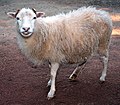Ovis
| Ovis | |
|---|---|

| |
| There are 7 species of Ovis. | |
| Scientific classification | |
| Domain: | Eukaryota |
| Kingdom: | Animalia |
| Phylum: | Chordata |
| Class: | Mammalia |
| Order: | Artiodactyla |
| Family: | Bovidae |
| Subfamily: | Caprinae |
| Tribe: | Caprini
|
| Genus: | Ovis Linnaeus, 1758 |
| Type species | |
| Ovis aries | |
| Species | |
|
See text. | |
Ovis is a
Terminology
Female sheep are called ewes, males are called rams or less frequently bucks or tups, neutered males are called wethers, and young sheep are called lambs. The adjective applying to sheep is ovine, and the collective term for sheep is flock or mob. The term herd is also occasionally used in this sense, generally for large flocks. Many specialist terms relating to domestic sheep are used.
Characteristics
Sheep are fairly small compared to other
The bodies of wild sheep (and some domestic breeds) are covered by a coat of thick
depending on the age of the animal).In wild sheep, both rams and ewes have horns, while in domestic sheep (depending upon breed) horns may be present in both rams and ewes, in rams only, or in neither. Rams' horns may be very large – those of a mature bighorn ram can weigh 14 kg (31 lb) – as much as the bones of the rest of its body put together. Rams use their horns to fight with each other for dominance and the right to mate with females. In most cases, they do not injure each other because they hit each other head-to-head, and their curved horns do not strike each other's bodies. They are also protected by having very thick skin and double-layered skulls.[4]
Wild sheep have very keen
Sheep have
Species
Seven species (and numerous subspecies) of sheep are currently recognized. The main recognized divisions are:[1]
| Image | Scientific name | Common Name | Distribution |
|---|---|---|---|
 |
Ovis ammon | Argali or mountain sheep |
central Kazakhstan in the west to the Shanxi Province in China |
 |
Ovis aries[5] | Domestic sheep | Domesticated |
 |
Ovis canadensis | Bighorn sheep | North America |
 |
Ovis dalli | Dall sheep or thinhorn sheep |
northwestern North America. |
 |
Ovis gmelini | Mouflon | eastern Turkey, Armenia, Azerbaijan, and Iran |
 |
Ovis nivicola | Snow sheep | northeast of Siberia |
 |
Ovis vignei | Urial | Central and South Asia. |
| Ovis gracilis | A fossil species from the Early Pleistocene of Taurida Cave, Crimea.[6] |
Behaviour
Sheep are social animals and live in groups, called flocks. This helps them to avoid
Mating

Mating in sheep is characterized by males competing for females in estrus.[9] Social rank in rams is established by male-male competition, known as the rut.[10] Females select from dominant males based on sexually selected characteristics such as body size and horn size, as those traits are desirable in offspring.
Females typically are separated from males outside the rut, but during the rut, females and males are found together.[10] Females that are oestrous isolate themselves from other ewes, and may be less mobile.[10] The rut is also linked with different ewe behaviour than during nonrutting periods.[10] These changes are characterized by decreased feeding, increased time observing their surroundings, and increased behaviour changes.[10] Ewes are also predicted to be slightly receptive to the displays of the rams.[10]
See also
- Aries, the Ram (astrological sign)
- Barbary sheep (Ammotragus lervia) another type of Caprinae
- , or blue sheep
References
- ^ OCLC 62265494.
- ISBN 0-8018-2525-3
- ^ ISBN 0-521-63495-4
- ^ ISBN 0-937548-08-1
- ^ ICZN (International Commission on Zoological Nomenclature) Opinion 2027
- ISSN 0031-0301. Retrieved 13 January 2024.
- S2CID 36036030. Retrieved 26 March 2021.
- ^ Schoenian, Susan. "Follow The Leader". Sheep 101. Retrieved 26 March 2021.
- PMID 11798432.
- ^ a b c d e f Gonzalez, Georges; Bon, Richard; Estevez, Imna; Recarte, Jose (2001). "Behaviour of Ewes (Ovis Gmelini Musimon x Ovis Sp.) During the Rut". Rev. Ecol. 56: 221–230.
- Bulanskey, S. 1992. The Covenant of the Wild. New York: William Morrow and Company, Inc. ISBN 0-688-09610-7
- Parker, D. 2001. The Sheep Book. Athens, Ohio, USA : Swallow Press / Ohio University Press ISBN 0-8040-1032-3
